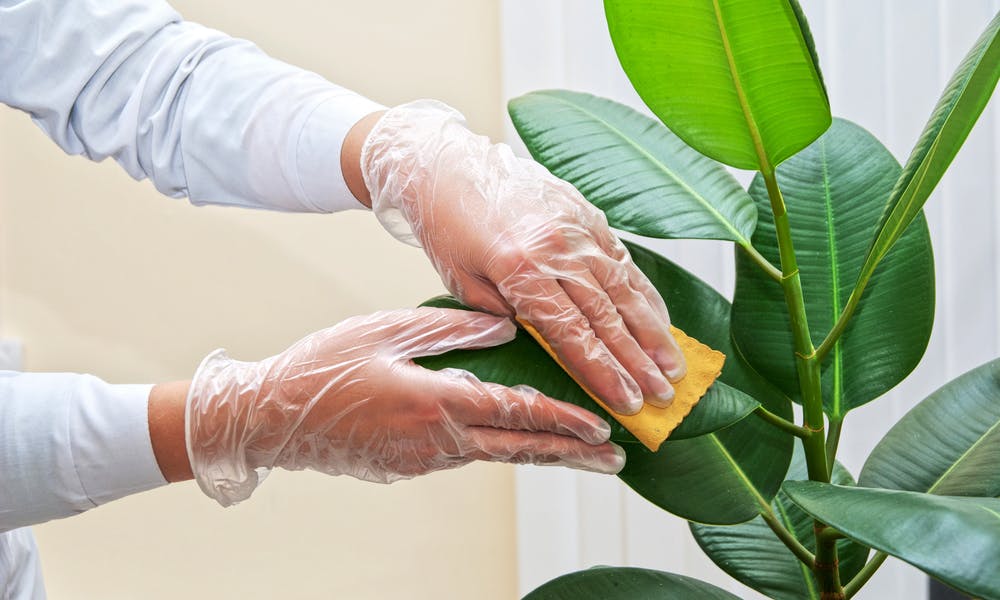MENU
What Should You Know about Rubber Plant Care?

Ficus elastica or commonly known as the rubber plant is known only in the form of a very beautiful houseplant, appreciated for its attractive foliage, like other ficus. However, in the Asian jungles from which it originates, it becomes a huge tree that can reach up to 55 meters in height. In nature, it produces small flowers, only pollinated by a specific wasp. They turn into tiny inedible figs.
In our home, rubber has a rapid growth that makes it possible to use it as a plant partition to separate two areas of a room or even adorn a ramp of a staircase. Some do not hesitate to fix it in the corner of the ceiling. There are many varieties of Ficus elastica, with variegated leaves of white, pink, or yellow color. All of them can form a nice decorative piece in our homes or offices.
In this article, we are going to develop the following points:
* Information about rubber plant growth environment
* Most frequent rubber diseases
* How to properly water your rubber plant?
* Pieces of advice about the maintenance of this wonderful plant
Information about Rubber Plant Growth Environment
This Ficus is an easy plant to grow, especially for beginners, because it tolerates some mistakes without suffering too much. However, if you want a plant that is healthy and fast growing, it is better to provide it with the necessary care. This tropical plant fears an atmosphere too dry and benefits from receiving maximum humidity to compensate for this lack. The perfect temperature can vary between 15 and 25 degrees C.
Rubber supports low light, which is why it is often placed in poorly lit offices, but it grows faster with good light. Therefore, it should be in a bright room, but not be directly exposed to the sun’s rays. A substrate of potting soil, garden soil, sand, and well-decomposed compost, suits it by putting gravel in the bottom of the pot to guarantee good drainage. Finally, avoid moving it too often, as it takes time to adapt to its new environment.
Most Frequent Rubber Diseases
Like all plants, rubber can get sick. The most frequent disease is leaf loss. It is normal when it is a question of regular losses and in limited quantity. However, in case of massive leaf loss, you should first check if your plant is well watered. Then, try to remember if you recently changed the place of the pot. It may also lack light if something is blocking it. Once you determine and solve the issue, it should quickly regain strength.
If the rubber leaves are turning yellow, it is often the result of an attack by red spiders. You only need to treat it with an organic miticide sold in garden centers. It should get its green color back in no time. Moreover, avoid chemicals, especially for your indoor plants. It can be toxic both for you and for your plant. Sometimes, white traces appear on the leaves. This is usually the result of mealybugs.
How to Properly Water Your Rubber Plant?
Ficus is a plant of tropical origin that needs water but not too much. To adjust this process, we advise watering your plant at least once a week. However, you must wait until the soil is dry before watering it again, or else it is going to drown and die. If the air in your interior is rather dry, especially in summer, you can water more often, twice or three times a week, respecting the same last rule.
On the contrary, during winter, you can space the watering a little more. Do not hesitate to spray water regularly on the foliage to improve its quality and prevent the leaves from drying out, especially in winter, when the heating is at full speed. Rubber plants can be placed in a pot on a bed of clay balls, which is filled with water so that evaporation brings moisture to the leaves.
Pieces of Advice about the Maintenance of This Wonderful Plant
So that your plant grows properly and stays this beautiful green color, you should take care of it regularly. You can pinch the young shoots to make them grow. We advise you to cut it once or twice a year, preferably at the end of winter and at the end of summer, because they are the best period to do so and your plant may have suffered from some damage due to climate change.
This plant support pruning very well. However, it is useless to fold the branches; a light pruning is enough if you want to have more beautiful and dense foliage. Do not forget that you must clean the leaves with a damp sponge if they are dusty. Finally, you need to properly water your rubber during the growing season to have great results.
Rubber is one of the most common houseplants. Being easy to grow, it is an ideal piece for decoration, with its broad shiny leaves, on a stair railing or a corner of the living room. It is a plant that is preferably grown alone given its large size. Taking care of it is not that hard because it is a strong plant that can resist through hard conditions. In general, you should water your plant regularly after that the soil becomes dry.
As with all flowers, rubber can get sick, either because of the environment or because of a mealybug or spider. You only need to regularly check the leaves and branches of the plant because rubber is quite vulnerable to mealybugs or red spiders. Finally, do not forget to clean the leaves from time to time and give it a light pruning.

